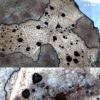
05-12-2025 17:33
 Bruno Coué
Bruno Coué
Bonjour, je serais heureux de recueillir votre avi

07-12-2025 09:24
De la pasada semana en Galicia EspañaEn el suelo

06-12-2025 00:19
 Viktorie Halasu
Viktorie Halasu
Hello, would anyone have this article, please? An

02-12-2025 18:59
This pair of ascos 2.5cm across were on recently b

02-12-2025 19:25
Buckwheat PeteHello, can anyone identify this hairy fungus growi

30-11-2025 12:53
 Edvin Johannesen
Edvin Johannesen
White short-stipitate apothecia found on thin twig
Coccomyces on Quercus leaves
Garrido-Benavent Isaac,
24-02-2014 18:47
This is a Coccomyces that was growing on dead leaves of Q. ilex subs. rotundifolia and Q. coccifera, in eastern Spain at around 200 m asl.
Following a key shared by B. Declercq here in Ascofrance, I'm not quite sure if my specimens belong to C. dentatus or C. coronatus. Macroscopically, they are more related to the former, microscopically to the later though. Perhaps there are other "intermediate species" which weren't included in that key.
Some of the traits that could help to identify it are:
- Spores 63-87 x 2'5-3'3(4) um, with one rounded end and the other somewhat sharpened, abundant granular content.
- Asci between 95-120 x 9-11 um.
- Paraphyses with more or less clavate tips, straight or slightly curved, surrounded by gel and 3-4 um width.
- Macroscopically, there can be seen 3 to 5 black, irregular teeth. Ascocarp diameter not exceeding 1mm diameter. Hymenium whitish to ivory. Despite I've not studied it yet, there are some black, smaller dots around the ascocarps that could be pycnidia.
Any suggestion will be appreciated!!
Cheers
Isaac

